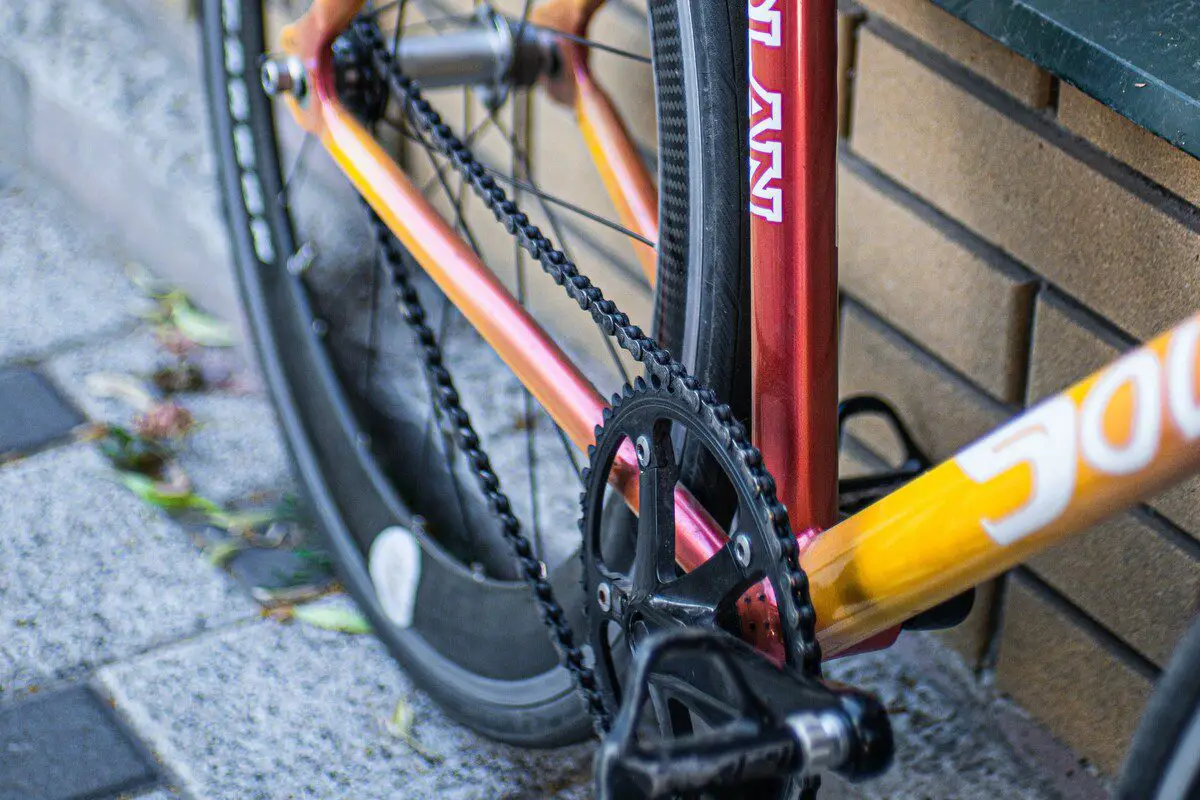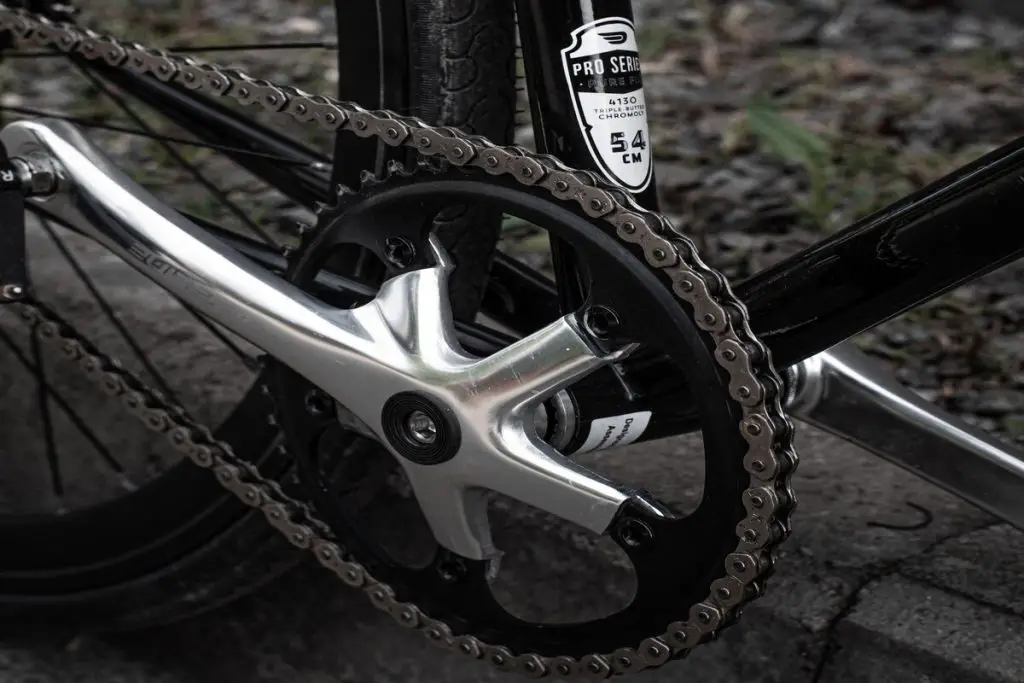Are you struggling to find the perfect fixed-gear bike chain that’ll make your ride a smooth, efficient machine? Well, my friend, you’ve come to the right place! In this blog post, we’re going to explore the ins and outs of choosing the ideal fixed-gear bike chain, making sure your bike performs at its best.
I’ll walk you through the things you need to consider when choosing bike chains and I’ll also give you the best options for your fixie. So, buckle up and get ready to learn everything you’ve ever wanted to know about fixed-gear bike chains. After all, knowledge is power, and with great power comes great responsibility…and, in this case, great bike rides!
What are bike chains?
A bicycle chain is a crucial component of a bike’s drivetrain that transfers power from the pedals to the drive-wheel, propelling the bike forward. It is made up of many individual pieces, including the pin, outer and inner links, bushing, and roller.

Most modern bicycle chains are considered roller chains and are made from plain carbon or alloy steel, although some are nickel-plated to prevent rust or for aesthetic purposes.
State Bicycle Co. Black Label 6061

State Bicycle Co. Black Label 6061
What should you consider when choosing a fixie bike chain?
When choosing a fixie bike chain, there are several factors to consider to ensure you get the best one for your needs. Here are some things to look for:
1. Durability
A fixie bike chain should be strong and durable enough to withstand the constant strain and pressure of fixed-gear riding. Look for chains made from high-quality materials like stainless steel or nickel-plated steel. Stainless steel is a bit more expensive but provides greater strength and durability, while nickel-plated chains provide extra corrosion resistance at a lower cost.
2. Compatibility
It is important to ensure that the chain you choose is compatible with your bike’s drivetrain, including the chainring and cog. All modern bicycle chains are made to the “one-half inch pitch” standard, meaning from rivet to rivet is nominally 0.5 inches, and the sprocket teeth are cut for this same standard to accept bicycle chains.
The drivetrain consists of the chainring, cog, and chain. The chainring is the large sprocket attached to the crankset, the cog is the small sprocket attached to the rear wheel, and the chain is the link between the two.
A properly tensioned chain is crucial for a smooth and efficient ride. Look for a chain with an appropriate length that can be properly tensioned on your bike.
3. Tension
A properly tensioned chain is crucial for a smooth and efficient ride. Look for a chain with an appropriate length that can be properly tensioned on your bike. One way to determine the appropriate length is to measure the old chain or use a chain sizing tool to determine the length you need.
Once you have the correct length, you can manually tension the chain to ensure it’s not too loose or too tight. One method of doing this is to adjust the chain to the recommended tension range, which can be found in your bike’s manual, or by measuring the amount of sag in the chain.
4. Weight
While not as crucial as other factors, the weight of the chain can affect the overall performance of the bike. While a lighter chain can improve acceleration and speed, it may be less durable over time and may require more frequent replacement. A heavier chain, on the other hand, may be more durable and long-lasting but may also add extra weight to the bike, which can negatively affect acceleration and speed.
5. Width
There are two sizes of chains that can be used on a fixed-wheel bicycle: 1/8″ and 3/32″. The most common one is 1/8″ as that is what is used on the track and BMX. On bikes that have been converted from gears to fix, 3/32″ is more likely to be used. Make sure to choose a chain that matches the width of your cog and chainring.
To determine the width of your cog and chainring, you can use a pair of calipers to measure their width. If the width is much larger than 3/32″, then use 1/8″. It is important to note that using a thicker 1/8″ chainring or cog with a thinner 3/32″ chain is not possible, as the chain is not wide enough and will not engage the teeth on the ring or cog.
6. Price
Fixie bike chains come at a range of price points, from budget-friendly to high-end options. Consider your budget when choosing a chain, but also keep in mind that a more expensive chain may offer better durability and performance.
7. Brand reputation
Look for reputable brands known for producing high-quality cycling products, such as KMC or Izumi. Their chains are likely to be more reliable and long-lasting.
8. Chain structure
Some fixie bike chains, such as the KMC City Hunter, feature a unique oval structure that can increase strength and durability, making them a good choice for aggressive riders or those who need extra reliability.

What are the best bike chains for fixie bikes?
Fixie bikes require a single-speed chain that is designed to withstand the constant tension and stress put on it by the fixed-gear drivetrain. Fixie chains are made thicker to handle the more intensive strain on the bike’s drivetrain that comes with riding fixed. There are several bike chains that are recommended for fixie bikes, and here are some of the best chains to consider:
1. KMC Z410 Fixie Chain
This chain from KMC is a popular choice for fixed-gear bikes and is known for its high quality. It is also one of the more affordable options.
2. KMC City Hunter Fixie Chain
This chain is a high-performance option for fixie riders who need durability and strength. It also has a 5-star rating and is the only chain with a flawless review rating.
3. Izumi Standard Track Fixed Cycling Chain
This chain is another high-quality option for fixie bikes, particularly for track cycling. It is known for its durability and smooth performance.
4. Shimano Ultegra Chain
While this chain is marketed for road bikes, it is still a great option for fixie bikes due to its lightweight and durable design. It is also a top-rated bike chain and a popular choice among cyclists
Can I use a regular chain on a fixed gear?
When it comes to fixed-gear bikes, using a regular chain may not be the best idea. While it is possible to use a regular chain on a fixed-gear bike, it is generally not recommended due to safety concerns and potential issues with durability and performance. Fixed-gear bikes require a specific type of chain that is designed to handle the constant tension and stress put on it by the drivetrain.
Fixie chains are thicker than regular chains and can handle the more intense strain on the bike’s drivetrain. Additionally, using a fixed-gear bike chain requires very little maintenance compared to traditional chains, making it an ideal choice for low-maintenance riders.
While some riders may choose to use a regular chain on their fixed-gear bike, it is important to keep in mind that it may stretch or break more easily, leading to potential safety concerns while riding.
If you want even more tips and insights, watch this video called “1/8″ vs. 3/32″ Chains, Gear Ratios & Skid Patches | Too Afraid to Ask” from the Zach Gallardo YouTube channel.
Conclusion
Well, folks, it’s time to chain up this post and ride off into the sunset. Have I helped you pedal your way toward a better understanding of fixed-gear bike chains? I sure hope so! I’d love to hear your thoughts, questions, or even stories of chain-related triumphs and woes in the comments section below. Remember, I read and reply to every comment.
Don’t forget to share this article with your fellow fixed gear enthusiasts and explore my blog for more cycling tips, tricks, and tidbits. As always, I appreciate your support, and I’m here to help you keep your bike chain game strong. Thanks for reading, and remember: a well-chosen chain is the link to a smoother ride!
Key takeaways
This article covered how to choose fixed-gear bike chains. Here are some key takeaways:
- Choosing the right fixed-gear bike chain is crucial for optimal performance and durability.
- Consider chain compatibility, width, pitch, material, and construction when selecting a chain.
- Determine the correct chain length by measuring the chainstay length and adjusting for chain tension.
- Compare popular fixed-gear bike chain brands and models to find the best option.
- Maintain your chain through regular cleaning, lubrication, and timely replacement.















